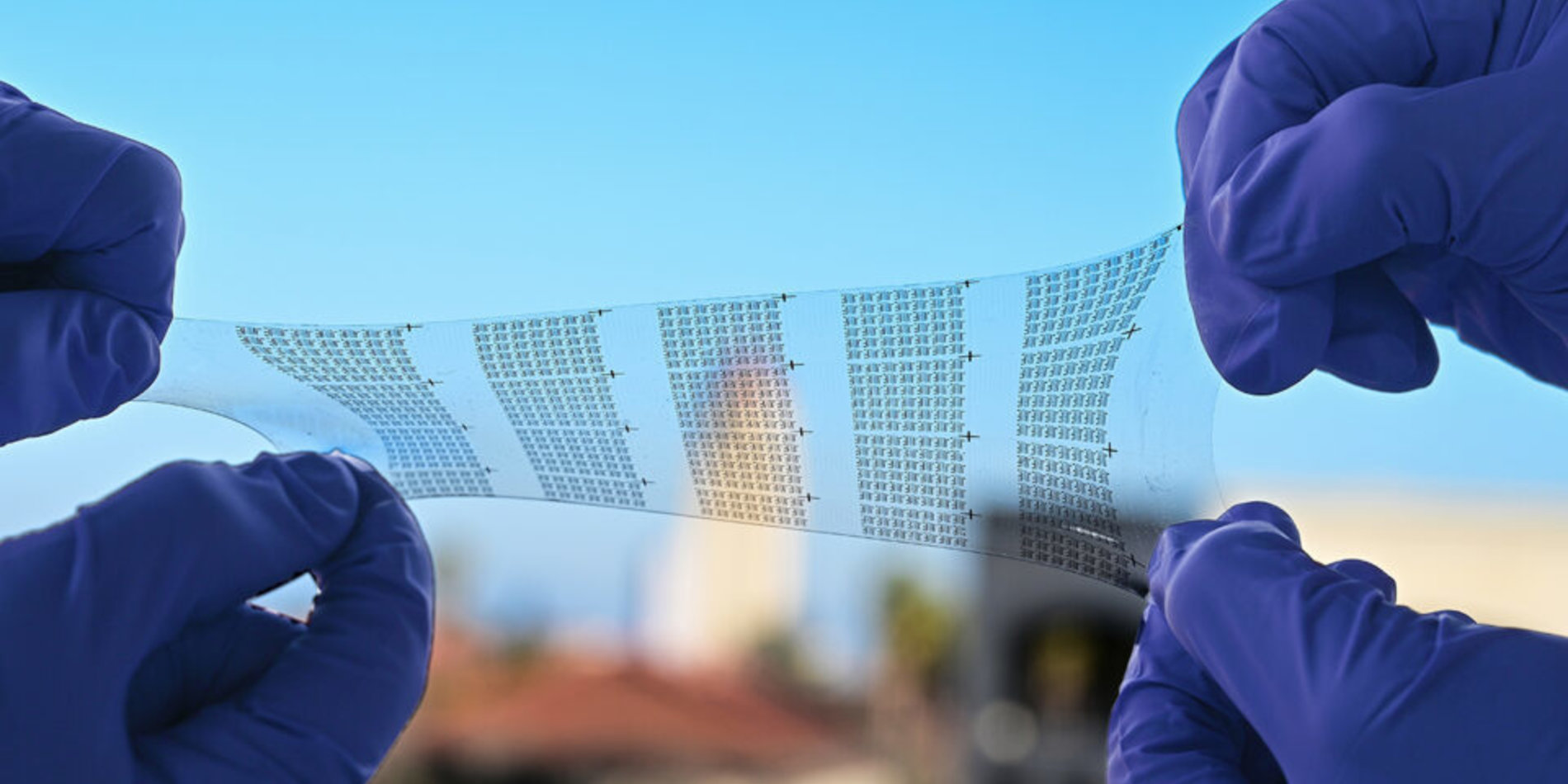Soft ‘e-skin’ generates nerve-like impulses that talk to the brain
Feature on Stanford News!
Mechanoreceptors in human skin can sense the delicate weight of a butterfly, feel the heat of a nearby flame or a cool drink, understand whether a hand is raised in a fist or a peace sign, and count the pulse of a loved one with a gentle touch. Engineers eager to create artificial electronic skin have so far been able to fashion soft, flexible materials that mimic each of these remarkable senses, but never have they created a single sheet with skin-like materials that can directly talk to the brain – until now.
While previous efforts required rigid electronics to convert the sensed signal into electrical pulses that the brain can read, researchers at Stanford University have produced soft integrated circuits that convert sensed pressure or temperature to electrical signals similar to the nerve impulses to communicate with the brain. The researchers hope someday that those signals might be directed to implanted wireless communication chips in the peripheral nerve to allow amputees to control prosthetic limbs. Other potential uses might include new-age implantable or wearable medical devices.
“We’ve been working on a monolithic e-skin for some time. The hurdle was not so much finding mechanisms to mimic the remarkable sensory abilities of human touch, but bringing them together using only skin-like materials,” said Zhenan Bao, K.K. Lee Professor in Chemical Engineering and senior author of the study appearing in the journal Science.
“Much of that challenge came down to advancing the skin-like electronic materials so that they can be incorporated into integrated circuits with sufficient complexity to generate nerve-like pulse trains and low enough operating voltage to be used safely on the human body,” said Weichen Wang, a doctoral candidate in Bao’s lab, who is a first author of the paper. Wang has been working on this prototype for 3 years.
Layers of technology
The goal was a soft integrated circuit that could mimic the mechanism of sensory receptors and run efficiently at a low voltage. Unfortunately, Wang’s first attempts demanded upwards of 30 or more volts and could not realize enough circuit functionality. “This new e-skin runs on just 5 volts and can detect stimuli similar to real skin,” he said.
Artificial skin will be critical to new-age prosthetic limbs that not only restore movement and functions, like grasping, but also provide sensory feedback (proprioception) that helps the user control the device with precision. Not only that but the sensory-skin material itself must stretch and return without fail, time and time again, all while never losing its nerve-like electrical characteristics.
The team invented a tri-layer dielectric structure that helped increase the mobility of electrical charge carriers by 30 times compared to a single-layer dielectrics, allowing the circuits to operate at low voltage. Interestingly, one of the layers in the tri-layer is nitrile, the same rubber that is used in surgical gloves. The majority of e-skin is made of many layers of skin-like materials. Integrated in each layer are networks of organic nanostructures that transmit electrical signals even when stretched. These networks can be engineered to sense pressure, temperature, strain, and chemicals.
Each sensory input has its own integrated circuit. Then all the various sensory layers must be sandwiched together into a single monolithic material that does not delaminate, tear, or lose electrical function.
Each electronic layer is just a few tens to hundred nanometers thick and the finished material of half a dozen or so layers is less than a micron.
“But that’s actually too thin to be handled easily, so we use a substrate to support it, which brings our e-skin to about 25-50 microns thick – about the thickness of a sheet of paper,” Bao said. “It is in a similar thickness range of the outer layer of human skin.”
Next-generation advances
The system is the first to combine sensing and all the desired electrical and mechanical features of human skin in a soft, durable form that could be used in next-generation prosthetic skins and innovative human-machine interfaces to provide a human-like sense of touch.
Their prototype complete, Bao, Wang, and team now embark on increasing complexity and scalability of their technology, adding wireless functionality, and ways to interface with the brain and the peripheral of the body.
Former postdoctoral scholars Yuanwen Jiang and Zhitao Zhang; postdoctoral scholar Donglai Zhong are co-lead authors of this research. Other Stanford co-authors include former postdoctoral scholar Snehashis Choudhury; postdoctoral scholar Jian-Cheng Lai; graduate student Huaxin Gong; former postdoctoral scholar Simiao Niu; former postdoctoral scholar Xuzhou Yan; former doctoral student Yu Zheng; postdoctoral scholar Chien-Chung Shih; graduate student Rui Ning; graduate student Qing Lin; former visiting scholars Deling Li (also of Beijing Tiantan Hospital, Beijing Neurosurgical Institute, Capital Medical University) and Yi-Xuan Wang (also of Tianjin University); postdoctoral scholar Chuanzhen Zhao; postdoctoral scholar Chengyi Xu; postdoctoral scholar Xiaozhou Ji; graduate student Yuya Nishio; postdoctoral scholar Hao Lyu; and lab director Jeffrey B.-H. Tok. Additional authors are from Gyeongsang National University, South Korea. Bao is also a member of Stanford Bio-X, the Stanford Cardiovascular Institute, the Wu Tsai Human Performance Alliance, the Maternal & Child Health Research Institute (MCHRI), and the Wu Tsai Neurosciences Institute; an affiliate of the Precourt Institute for Energy and the Stanford Woods Institute for the Environment; and faculty fellow of Sarafan ChEM-H.
This research was funded by the Stanford Wearable Electronics Initiative (eWEAR), Stanford SystemX Alliance, and the Wu Tsai Neuroscience Institute. Part of this work was performed at the Stanford Nano Shared Facilities (SNSF), which is supported by the National Science Foundation.
Additional Coverage:
New Scientist | Stretchy electronic skin responds to touch and pressure like real skin
The Independent | Scientists invent electronic skin that gives amputees sense of touch | Yahoo News
MIT Technology Review | A soft e-skin mimics the way human skin can sense things
STAT | Soft, stretchable electronic skin could reconstruct the sense of touch
Nature | Soft ‘Electronic skin’ mimics our sense of touch


